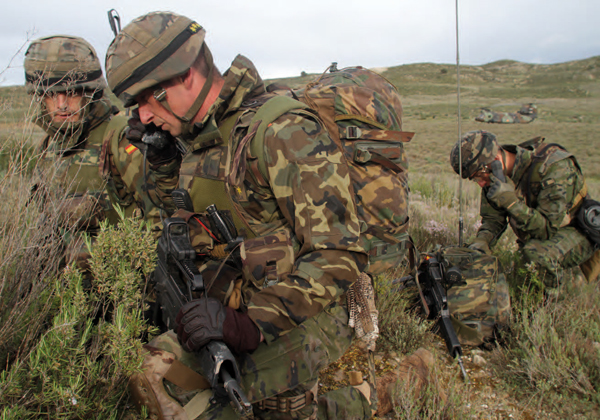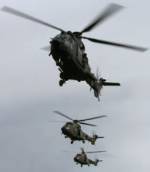- Home
- Feature Articles
- Full article
The 'Paras' land safely
Monday, May 18, 2015
Number: 010
At “San Gregorio”, the Parachute Brigade completes the training of two Task Groups for any mission for which they may be required
The capture of a seaport and an airport were the two final operations of the “LP Thunder” exercise, which brought over 1,600 members of the 6th “Almogávares” Parachute Brigade (BRIPAC in its Spanish acronym) and 550 soldiers from other units to the exercise area of the “San Gregorio” Training Field from 20th to 30th April.
The first of the operations was the final exercise the High Availability Task Group (GTAD) was due to carry out to be qualified to enter the availability phase. During the second half of the current year, the Task Group will be at the disposal of the Chief of Defence Staff for any mission in which it may be required.
The company of Captain Carlos E., structured as a sub-task group with three companies of fusiliers and their associated artillery and sapping support groups, was in charge of capturing the seaport of an allied country being used by insurgents. Those insurgents were allegedly supported by a neighbouring country with which relations are strained, due to a great extent to the presence of a large community of its citizens in the allied country. “This seaport may serve as a bridgehead for more troops, hence the importance of controlling it”, explained the Captain while he crouched near the target with his two radio operators – one to communicate with its staff and the other, with senior command. From his position on high ground, he followed developments and received and conveyed information.

Aerial assault operation
The crew was transported to the vicinity of the seaport on several helicopters which landed in three different locations as part of a complex air-assault operation which required precise coordination in order to guarantee synchronisation.
The troops are now advancing. A group, towards the civilian area of the airport; another, to the military area; a third group, towards the north to block access – because it is suspected that the insurgents may take that route. Although the seaport is in the territory of a friendly country, it is controlled by a mafia group known to have contact with the rebels, and there is a chance that they may become hostile when they see the military. The gloomy predictions materialise but, in spite of the difficulties, the target is captured.
Over 2,000 soldiers
have been trained
at 'San Gregorio'
Unique capabilities
The Parachute Brigade is the only unit in the army able to launch personnel from an aircraft and, therefore, to put together a Paratroopers Task Force (GTPAC) whenever the Chief of Defence Staff requires it. In this exercise the GTPAC, led by the 2nd Parachute Battalion “Roger de Lauria”, also captured an airport as part of its training.
On this occasion the members of the Brigade, launched in several waves from two T-21s and a T-10 of the Spanish Air Force, boarded from two sites: The Zaragoza Air Base and the Ablitas Airfield in Navarra. Out of a total of 494 airdrops, 134 used manual parachutes and 360, automatic ones.
The 30 loads dropped during the exercise were prepared at the Zaragoza Air Base. They included a Light Gun artillery piece, mules and high speed cargo (which can be dropped faster, e.g. ammunition, rations, water, etc.). The preparation and drop of those loads is yet another of the unique capabilities of BRIPAC.
The Task Group includes soldiers that will be in the next contingent to Iraq. This exercise marked the end of the generic training phase. Specific training will start shortly.
Coordinated exercisesOthers units have joined the Brigade at “San Gregorio” to provide support and, at the same time, undergo their own training. They include the Army Air Corps (FAMET), which carried out a drill deploying 25 aircraft from all its Battalions and from the FAMET Training Centre. |
|
ARMY UNITS
- Araba Álava |
- Albacete |
- Alicante |
- Almería |
- Asturias |
- Ávila |
- Badajoz |
- Barcelona |
- Burgos |
- Cáceres |
- Cádiz |
- Cantabria |
- Castellón |
- Ceuta |
- Ciudad Real |
- Córdoba |
- A Coruña |
- Cuenca |
- Girona |
- Granada |
- Guadalajara |
- Gipuzkoa |
- Huelva |
- Huesca |
- Islas Baleares |
- Jaén |
- León |
- Lleida |
- Lugo |
- Madrid |
- Málaga |
- Melilla |
- Murcia |
- Navarra |
- Ourense |
- Palencia |
- Las Palmas |
- Pontevedra |
- La Rioja |
- Salamanca |
- Segovia |
- Sevilla |
- Soria |
- Tarragona |
- Santa Cruz de Tenerife |
- Teruel |
- Toledo |
- Valencia |
- Valladolid |
- Bizkaia |
- Zamora |
- Zaragoza



 The 31st Electronic Warfare Regiment displayed its workstations looking for vulnerabilities in the communications of the Task Groups. The Asymmetric Enemy Company of the Opposing Force from the “San Gregorio” National Training Centre joined the operations to play the role of the insurgents and the local mafia groups.
The 31st Electronic Warfare Regiment displayed its workstations looking for vulnerabilities in the communications of the Task Groups. The Asymmetric Enemy Company of the Opposing Force from the “San Gregorio” National Training Centre joined the operations to play the role of the insurgents and the local mafia groups. 